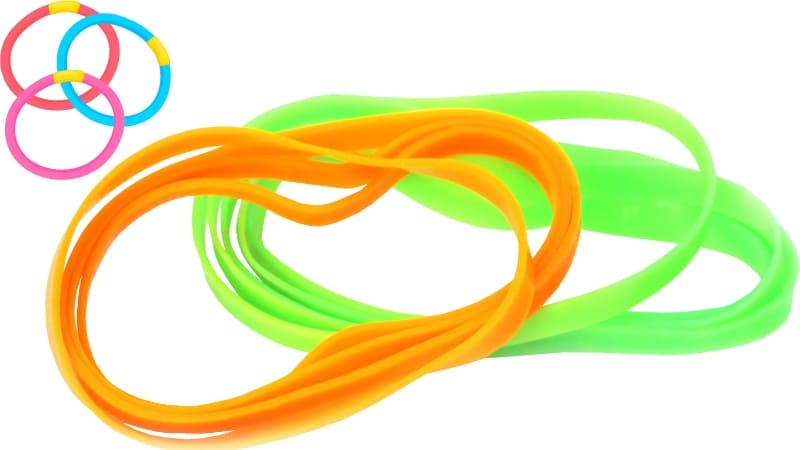How Rubber Bands Are Helpful With Braces
Updated: 20 Jan 24
295

Maryam Khalid
Rubber bands, also known as elastics, are helpful in the alignment of your teeth. They play an essential role in fixing your bite. With several problems with teeth and jaws, these bands help a lot in orthodontist’s treatment.
These tiny bands look like any other elastic band but are smaller. They are super stretchy and put pressure when you move your jaws. The best thing about them is that your orthodontist will prescribe you, keeping your problem in mind and how you can use them to eliminate the problem.
Moreover, don’t judge them by their size. They can fix your big to tiny problems with regular usage. This article will tell you everything about how rubber bands are important, including their advantages and disadvantages.
Rubber Bands – Function
Braces and rubber bands can mainly help you with these problems, but your orthodontist can suggest how to wear them.
- They provide the force needed to move the teeth, helping them to the desired position.
- They correct bite issues like overbites, underbites, open bites, and crossbites.
- They align the jaw by pulling it forward or backward.
Types of rubber band braces
The rubber bands are available in a variety of types, keeping functionality in mind. Let’s see them in detail.
1. Interarch Bands
The interarch bands are supposed to connect the upper and lower cases of teeth. They stretch from the top tooth to a bracket on the bottom tooth. They align the jaws as well as correct bite issues. They are available in various sizes and strengths and can also be customized according to patient preference and need.
2. Intra-arch Bands
The intra-arch bands function within the same dental arch. They help fill gaps between the teeth, align the row, and correct tooth positioning. They can be connected to multiple teeth in a row to put extra force and do the job.
3. Class I, II, and III Elastics
Class I is used for adjustments in tooth positioning. Class II can correct an overbite by pulling the upper teeth backward and the lower teeth forward. Class III treats underbites.
4. Triangle rubber band braces
Triangle rubber bands are fixed in a triangular pattern. It connects three teeth at once. They are helpful with specific jaw movements, such as rotating and aligning.
5. Box Elastic rubber band braces
Just like its name, the box elastic rubber bands are formed in a box shape. With the four corners, they connect four teeth at once. They are helpful in complex tooth movements such as moving, rotating, and applying force in different directions. The formation of square or rectangle shapes often fixes bite issues as well.
6. Vertical Elastics
Vertical elastic bands are a must for fixing closed and open bites, where the upper teeth case and lower teeth case don’t touch when the mouth is closed.
How to Use Rubber Bands For Braces?

There are tiny hooks attached to your braces. These hooks hold rubber bands and form different shapes, catering to various issues accordingly. Ask your orthodontist how to wear them, but YouTube is always here to the rescue if you still have issues!
You can use your hands; moreover, there are specific plastic tools available that can ease the process and prevent you from slipping them from your hands.
Advantages
Rubber bands are very influential. They can fix complex dental issues. Besides this, patients have control over the treatment, but yes, consistent and regular wear can ultimately speed up the process. Significantly enhance the effectiveness of braces in correcting complex dental issues.
Disadvantages
These bands are often uncomfortable. Especially when you are introduced to them, they can cause soreness as well, but the only thing to remember is to ignore them for a few days, and then you will be good to go!
Moreover, people find their maintenance a big task. It requires discipline and responsibility to wear them on time and maintain them by regular cleaning and discarding in case of breakage.
They are visible and draw attention to the mouth quickly, so don’t hesitate to look for the future outcome before anything else. Furthermore, they must be removed while eating, which is another inconvenience.
Maintenance and Care
Always listen to your orthodontist. Your doctor is the only one who can guide you the best. Take care of your oral hygiene and change the braces when needed. Do not miss your doctor’s appointments at all. Be mindful and responsible to see the quick results.
Conclusion
Rubber bands for braces are mandatory for specific problems. They cause discomfort and require maintenance, but look at the bigger picture and go for it. The best thing about them is they are available in so many colors. So you can mix and even match according to your style and preference.
I hope this article helps you understand everything about rubber bands for braces in detail.
FAQs
What are rubber band braces for?
Rubber bands for braces are essential in orthodontist treatment. They help fix the bite along with movement, rotation, and alignment of teeth.
Do rubber bands on braces hurt?
No! They can cause discomfort and soreness, but they are not hurtful. With regular use, you will get used to it over time and won’t even feel them.
How fast do rubber bands move teeth?
It takes time to get used to it with rubber bands, just like the braces and wires. You don’t want them to move too quickly because it can damage the roots. Usually, it takes five to eight months to correct the alignment and movement of the jaws.
Please Write Your Comments